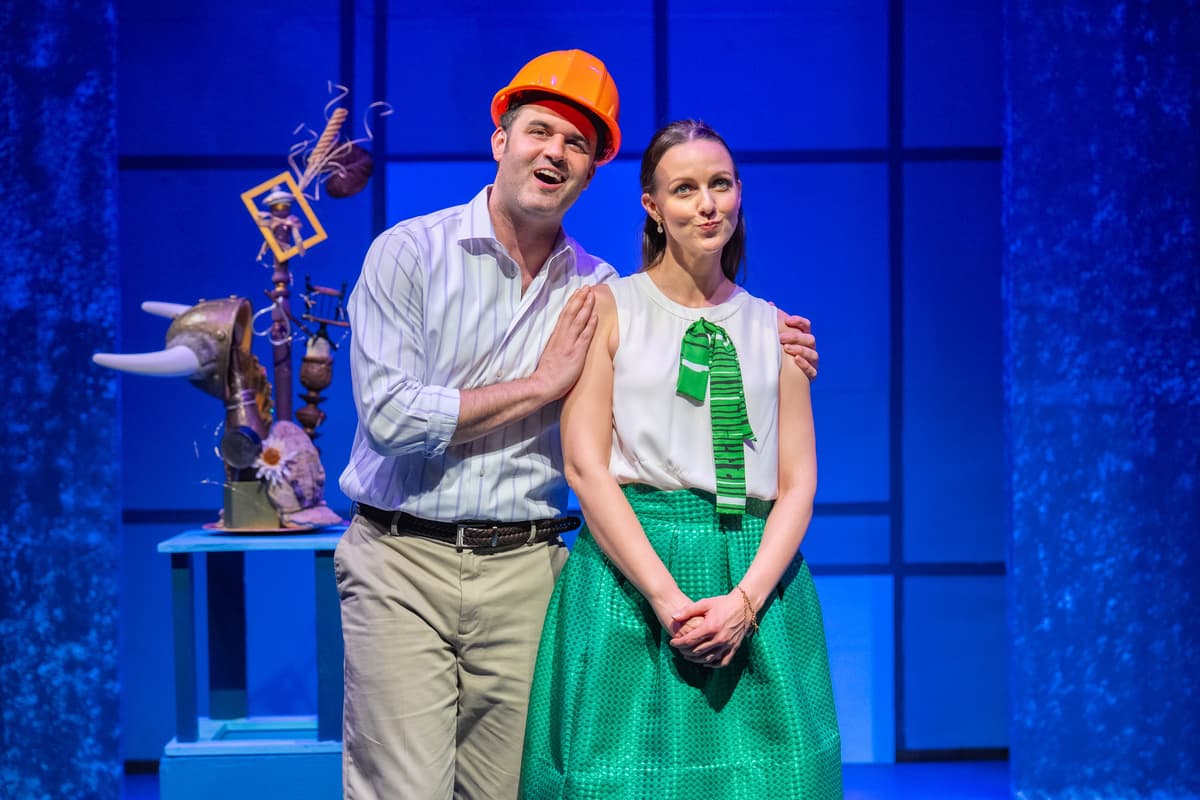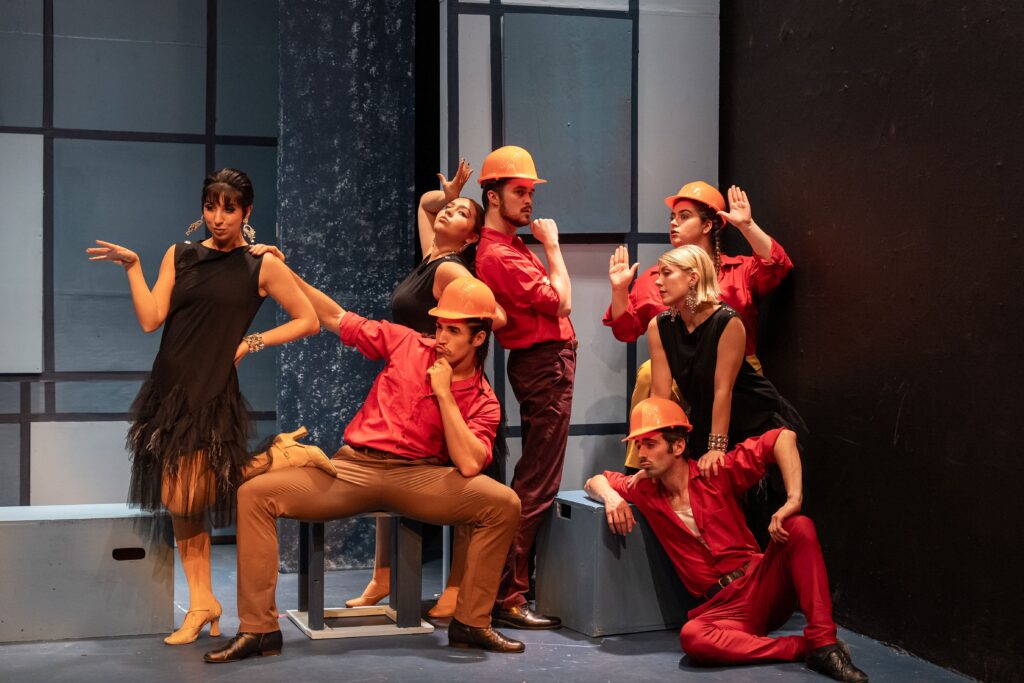A Rarely Revived Musical, ‘Skyscraper’ Captures a Unique Moment in New York City’s History
Although ‘Skyscraper’ is hardly a classic, it gives us a convincing and thoroughly entertaining portrayal of what the city felt like to the typical New Yorker at the midpoint of the 1960s.

‘Skyscraper’
Directed and Choreographed by Avital Asuleen
Urban Stages
Through November 17, 2024
While watching the charming new production of the rarely revived 1965 musical “Skyscraper” at Urban Stages, I kept coming back to the same thought: Even though New York is the setting for many major musical comedies, relatively few are essentially about New York — particularly the New York of the current moment, whatever that may be.
Some are about specific aspects of the time and the place, i.e., “West Side Story” and “Golden Boy,” while others are glamorized depictions of the New York of long ago, like “Wonderful Town” and “Hello, Dolly!”
As with “On The Town,” which for 80 years now has stood as the definitive account of the city in the World War II period, the creators of “Skyscraper” — librettist Peter Stone, lyricist Sammy Cahn, and composer Jimmy Van Heusen — were writing about the great city in the here and the now, and in doing so they captured what turned out to be a unique moment in our cultural history. Although “Skyscraper” is hardly a classic on the level of “On The Town,” it gives us a convincing and thoroughly entertaining portrayal of what the city felt like to the typical New Yorker at the midpoint of the 1960s.
The New York it gives us is the city at the specific moment when its residents realized that it had a past worth preserving at the same time it was eagerly pushing toward the future. In that sense, 2024, with all the much-deserved hoopla surrounding the 50th anniversary of the publication of “The Power Broker,” is the right moment to revive it.
In 1965, Manhattan — and the world — had just lost the magnificence that was the original Penn Station, but, conversely it was also when the author and activist Jane Jacobs had just, to the surprise of everyone, won the uphill battle to prevent Robert Moses from demolishing the entirety of Greenwich Village to build yet another of his superhighways to nowhere. At the same time, much of the Lower West Side was about to be bulldozed to make way for what became the World Trade Center, despite the protests of the people who lived and worked there.

“Skyscraper” gives us a dreamer, a wistful, fantasy-minded young lady (Rachel Lauren James) whose head is already so far up in the clouds that for her to take the elevator up to the 100th floor would be redundant. She plays opposite a leading man (Travis Murad Leland) who seems practical and ambitious by contrast, but who has far-flung dreams of his own.
When the producers, Cy Feuer and Ernest Martin, lured the celebrated actress Julie Harris to star in the original production, they doubtlessly sold it to her on the premise that it was a musical version of Elmer Rice’s 1945 “Dream Girl,” which is built around a great role for a funny, quirky actress like Harris. By the time Stone, Cahn, and Van Heusen had finished “Skyscraper,” the “Dream Girl” elements were minimized and even now they sometimes seem extraneous.
In 2024, the chance to dwell in the New York of 60 years ago seems like a dream enough in and of itself. Now, the most salient point regarding the leading character is that she wants to hold on to a decrepit brownstone that the rest of the world wants to demolish to make way for New York’s latest mega-skyscraper; the day-dreaming angle is strictly secondary.
The fantasy sequences are fun, in the spirit of Liza Elliott’s surreal dream production numbers in “Lady in the Dark.” At the same time, the dream numbers, like the opening “Occasional Flight of Fancy,” don’t seem any more or less dreamlike than than those that purport to depict New York reality – not to mention realty – especially “The Gaiety,” an ode to dining in an old-fashioned delicatessen, and “Haute Couture,” a spoof on the high fashion industry.
The project represented a major moment for Cahn and Van Heusen, who were among the most successful songwriters in the entirety of the Hollywood studio era and yet never succeeded in creating a classic Broadway show, whether separately or as a team.
“Skyscraper” did give us two songs that had a life of their own. “Everybody Has the Right to Be Wrong” was recorded by Frank Sinatra, Bobby Darin, and, very recently, Veronica Swift — and it’s a song that seems highly apropos in the current political moment. The powerful Act II ballad “I’ll Only Miss Her When I Think of Her” was sung by practically everybody, perhaps most memorably by Tony Bennett.
The other songs are tuneful and memorable; “Run for Your Life” and “Opposites” show that Cahn and Van Heusen could write first-rate contemporary musical theater, songs that delineate character and advance the plot. So does “Local 403” a number in which construction workers whistle at girls; here, the current producers avoided the issue of political correctness by making it more gender neutral, though I wouldn’t say “woke.”
It probably was the overall charm of the original 1965 cast album, starring Harris and Peter Marshall, who died in August at the age of 98, that inspired Regeneration Theatre, Combustion Collective, and Nelda Yaw Buckman to present this new production — the first time it’s been staged at New York since 1966.
This is a very well done small-scale production. Matthew Stern’s quartet orchestrations are rich and full. Ms. James is a far better singer and dancer than Julie Harris — a major example of a non-musical leading lady in a big musical — and she imbues Georgina with quirky characteristics of her own. Roger, originally played by Charles Nelson Reilly and here by Brian C. Veith, is more problematic: He’s somehow both a comedy second banana, Georgina’s wacky best friend who is at the same time conspiring against her for his own ends, and the third member of a love triangle plot. It’s an at least slightly flawed book, but a very fun show nonetheless.
Mr. Leland, who like Peter Marshall in 1965 is a skyscraper unto himself, expertly conveys a very nuanced portrayal, as an idealistic but firmly grounded architect. In “More Than One Way,” his Tim convincingly conveys his dreams to construct a building that will reach the stars and act as an “elevator to the sky,” echoing JFK’s inaugural address.
Far from being the leader of the anti-preservationist opposition, in the end Tim gifts Georgina with a book by Jane Jacobs. Rather than blindly genuflecting at the altar of progress, he’s the first to admit that many skyscrapers are hideous, and is willing to put everything on the line to insure that this new construct will be one of the great ones.
Tim anticipates “No One Is Alone” in Sondheim’s “Into the Woods” in the message that “giants can be good.” It’s up to Tim to convince Georgina, and the audience, that we can preserve the best aspects of yesterday even as we steadfastly march into tomorrow.
In the end, that’s what “Skyscraper” is all about — and New York as well.

